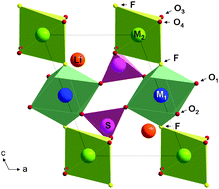LiMSO4F (M = Fe, Co and Ni): promising new positive electrode materials through the DFT microscope
Abstract
A theoretical study of the

* Corresponding authors
a
LRCS-CNRS, Université de Picardie, 33, Rue Saint-Leu, 80039 Amiens Cedex, France
E-mail:
christine.frayret@u-picardie.fr.
Fax: +33 322827590
Tel: +33 322827586
b ICMCB-CNRS, Université Bordeaux 1, 87, Av. Dr A. Schweitzer, 33608 Pessac Cedex, France
c Materials Department, University of California, Santa Barbara CA 93106-5050
A theoretical study of the

 Please wait while we load your content...
Something went wrong. Try again?
Please wait while we load your content...
Something went wrong. Try again?
C. Frayret, A. Villesuzanne, N. Spaldin, E. Bousquet, J. Chotard, N. Recham and J. Tarascon, Phys. Chem. Chem. Phys., 2010, 12, 15512 DOI: 10.1039/C0CP00517G
To request permission to reproduce material from this article, please go to the Copyright Clearance Center request page.
If you are an author contributing to an RSC publication, you do not need to request permission provided correct acknowledgement is given.
If you are the author of this article, you do not need to request permission to reproduce figures and diagrams provided correct acknowledgement is given. If you want to reproduce the whole article in a third-party publication (excluding your thesis/dissertation for which permission is not required) please go to the Copyright Clearance Center request page.
Read more about how to correctly acknowledge RSC content.
 Fetching data from CrossRef.
Fetching data from CrossRef.
This may take some time to load.
Loading related content
